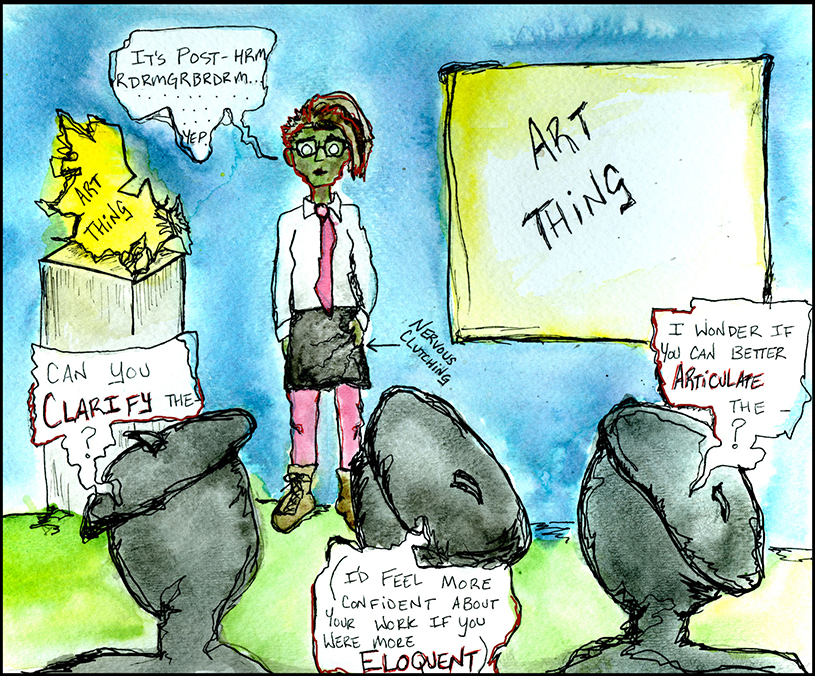
On April 18 and 19, the School of the Art Institute of Chicago (SAIC) hosted a small symposium titled “Art Words: These are the words you will be assessed by.” The words set to be discussed were “Eloquence,” “Articulate,” “Clarity,” and the phrase “Defend Your Work.” It is the second symposium SAIC has hosted on assessment, or grading, parameters in art education.
It may not seem clear to some at first, but the subject matter of this symposium crucially matters to all students attending SAIC. Many students understood this importance: The student discussions held on the first day was heavily attended, with most of the seats taken.
The second panel was hardly attended at all. It consisted of Art History Professors James Elkins and Delinda Collier, who coordinated the symposium as a whole, as well as Felice Dublon, dean of Student Affairs, and Frank Piatek from the Painting and Drawing department.
Two art scholars not currently affiliated with the school were also on the panel: Saul Ostrow, well-known art curator, critic, and art editor of BOMB magazine; and Laurie Fendrich, a prolific artist and scholar who has written many articles criticizing current assessment tools in art education.
This panel should have been just as crucial to the students at SAIC because it offered a chance to hear experts responsible for implementing assessments in art programs address their own discomfort and disagreements with the current system.
The Higher Learning Commission (HLC) is the group of people who decide whether SAIC is accredited or not. They base that decision partially on student performance, which is decided by assessments, which are decided (in part) by certain words.
Without accreditation, SAIC can’t offer federal financial aid to its students. Students who use federal loans and grants to offset the steep tuition of the school would not be able to attend without the federal money, and the federal money depends upon the use of assessment parameters that comply with the HLC.
Such assessment parameters at our school require that students understand and demonstrate these particular words — eloquence, clarity, and articulation — when defending or discussing their art.
It was surprising to hear how unhappy and concerned artists, professors, and school administrators were with the rubrics and the specificity of these words.The main focus of the discussion was on how far removed and limiting these rubrics and methods of assessment seem to be from the core issues of making art.
Much of the problem occurs because students are asked to use specific language when discussing the motives and personal practices of art-making without learning the theories or history of that language. This can hit close to home for student artists: Art is often personal, and includes many complicated associations, concepts, and emotions.
One of the problems might be that the language we’ve adopted to discuss art making is perhaps more appropriate to another discipline.
Fendrich presented this conundrum bluntly, saying, “I don’t see that we are helping students to express themselves when we drive them into this language, the language students are now using when they talk about their art. [It is] a language that they are picking up in a vague way … the language of, basically, critical theory.”
She went on to state that since artists, scholars, and critics alike really don’t know what art is, in any comprehensively definable sense, the language asked for sounds really specific when applied to the humanities, but in an art context, it can’t be. The endless parsing of such words is probably irrelevant to the making of the art.
As discussion continued, another issue common in contemporary art schools came up. It seems that by imposing a rubric with specific language requirements taken from humanities disciplines (such as literary or cultural criticism), academic institutions are asking student artists to also serve as their own art critics when presenting their work.
Professor Elkins pointed out that this type of artistic self-awareness on the part of the artist has rarely been present, much less required, in art history. Rarely has an artist needed to defend their work with eloquence and clarity. The art has spoken for itself.
Such institutional requirements might also ask that the artist solve many of the mysteries of their process in order to properly and thoroughly articulate their work so they can pass a class. This poses a problem for professors. If the student sets the criteria, the professor no longer has a responsibility to judge the work from a point of expertise; they can only agree or disagree with how the student has described it.
This moves the art critique discussion from process (the making) to theory (the meaning), and students come away from classes preoccupied with how to position their art in culture, instead of how they are creating it.
The second panel discussion ran less than the two-hour time allotted due to the brief audience discussion at the end. There were not enough people to field and carry a large discussion of the issues brought to light during the panel.
“Art Words” happened so close to the end of the academic year that many students missed it. Considering that it raised more concerns than it answered, it will be interesting to see how this conversation develops going forward, and how it might affect student work.
Elkins and Collier are including the transcripts of all their symposia discussions in books from each year discussing and examining art assessment requirements. The books will be short (100 pages) and offer administrators, instructors, and students insight into how rubrics function in art institutions.







